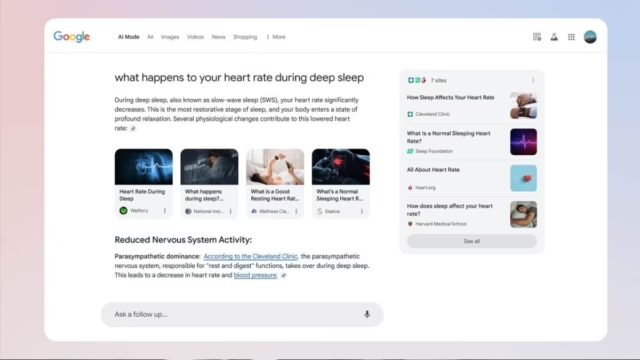Have you ever typed something into Google and felt like it knew exactly what you meant even if your words weren’t perfect? That’s not magic. That’s AI Mode doing its job behind the scenes.
Google has continually been proper at locating stuff. But now, with AI mode becoming more common, it is turning into smart at knowing what you sincerely want, not simply what you typed. This new version of Google Search is beginning to feel more like a helpful assistant than just a search engine.
So, what’s AI Mode exactly? Why is it such a big deal? And how is it making life less complicated for college students, specialists, commercial enterprise owners, and everyday humans?
Let’s unpack it in simple terms.
What Is AI Mode in Google Search?
Think of AI Mode as a layer of intelligence that sits on top of your usual Google experience. It’s not just about showing results. It’s about reading between the lines.
For example, say you search for
“best way to share monthly reports securely online.”
Google used to just throw a list of links at you. Now, thanks to AI Mode, it might give you a short summary, suggest the right tools, and even guide you step-by-step. It may highlight something like this helpful guide on sharing financial reports safely online, which breaks down secure options without the tech jargon.
That’s the power of intent-based search. It’s not only about what you say but also what you mean.
How It Works (Without Getting Too Technical)
AI Mode in Google Search uses advanced tools like natural language processing (NLP), machine learning, and large language models to make sense of your query.
But what does that mean for you?
It means Google is now capable of:
- Understanding context
- Predicting what you’re really asking
- Offering direct, meaningful answers
- Guiding you to next steps even if you didn’t ask for them yet
It learns from the billions of searches it handles daily and gets better over time. It doesn’t just learn words it learns patterns, problems, solutions, and user behavior.
Why It Feels Like a Human Conversation
Have you noticed that you can now follow up on a search without starting from scratch?
Let’s say you looked up “digital record systems for accounting.” You could ask right after:
“Are they secure?”
Google will understand that you’re still talking about the same thing. In fact, it might pull up content like this well-explained piece about how digital records improve internal controls, which connects the dots in a way that’s natural to follow.
That’s how Google is becoming more conversational. It doesn’t just search. It talks back.
What’s New in the Results?
You might notice some changes in how search results look when AI Mode is active:
- Quick summaries at the top of the page
- FAQs pulled from trusted sites
- Suggested next questions that make sense
- Highlighted answers from specific articles
- Sometimes even step-by-step instructions
This can save users tons of time. Instead of opening 10 links, you get the best parts right away. But you can still dive deeper if you want.
Real-World Scenarios Where AI Mode Helps
For Students
Let’s say you’re studying finance and searching for how companies store their digital reports. Earlier, you’d spend 30 minutes finding the right source. Now? Google might suggest articles like this one that breaks down digital adoption in simple language. Less guesswork, more studying.
For Business Owners
Running a small business? You might Google “Best tools for tracking inventory in 2025.” AI Mode not only gives you tool names but also shows pros, cons, pricing, and user reviews sometimes right in the results.
For Creators & Bloggers
Creating content? AI Mode rewards genuine answers and simple structure. No fluff. If your blog clearly answers questions and helps users, it has a better chance of showing up even with fewer backlinks.
But It’s Not All Sunshine: Challenges of AI Mode
1. Privacy Concerns
To personalize your results, Google tracks your behavior. What you search, when, and from where. Some users are uncomfortable with this level of data tracking.
2. Algorithm Bias
AI learns from the internet, which isn’t always fair or balanced. This means it can sometimes promote content that’s not fully accurate or is one-sided.
3. Content Saturation
If AI only shows the most popular or established sources, smaller blogs or newer websites might get buried even if they offer great insights.
How You Can Make the Most of AI Search

Whether you’re a user or a content creator, here’s how to benefit from AI Mode:
Ask Clear Questions
Don’t overthink your search. Write naturally, just like you’re talking to a person.
Follow the Suggestions
AI Mode will often offer follow-up questions. These can lead to better answers than your first search.
Create Helpful, Honest Content
If you’re writing for the web, focus on solving problems, not just ranking. Explain ideas simply. Break things into steps. Use examples.
What the Future Looks Like
Google’s not stopping here. In fact, AI Mode is just the beginning.
Soon, we might see:
- Multimodal search: where you combine text, images, and voice in one query
- Real-time translations for global learning
- Deeper integration with Google Workspace, Maps, YouTube, and other products
- Even more accurate summaries using AI
This means the web is about to become even more personalized and fast.
Final Words
The way we search online is changing fast. AI Mode in Google Search is helping us move from just typing keywords to actually having smart, useful conversations.
You don’t need to be a tech expert to see the difference. It’s already here in your everyday searches. When you’re a student, business owner, researcher, or someone just trying to find tonight’s dinner recipe, Google is learning how to help you better.
But here’s the best part:
This shift means content with real value wins. If you write clearly, answer real questions, and focus on helping, Google’s AI will notice.







